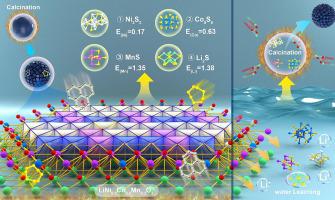当前位置:
X-MOL 学术
›
Waste Manag.
›
论文详情
Our official English website, www.x-mol.net, welcomes your feedback! (Note: you will need to create a separate account there.)
Resource recovery and regeneration strategies for spent lithium-ion batteries: Toward sustainable high-value cathode materials
Waste Management ( IF 8.1 ) Pub Date : 2024-03-11 , DOI: 10.1016/j.wasman.2024.03.014 Kunhong Gu , Chiharu Tokoro , Yutaro Takaya , Jiang Zhou , Wenqing Qin , Junwei Han
Waste Management ( IF 8.1 ) Pub Date : 2024-03-11 , DOI: 10.1016/j.wasman.2024.03.014 Kunhong Gu , Chiharu Tokoro , Yutaro Takaya , Jiang Zhou , Wenqing Qin , Junwei Han

|
Traditional cathode recycling methods have become outdated amid growing concerns for high-value output and environmental friendliness in spent Li-ion battery (LIB) recycling. Our study presents a closed-loop approach that involves selective sulfurization roasting, water leaching, and regeneration, efficiently transforming spent ternary Li batteries (i.e., NCM) into high-performance cathode materials. By combining experimental investigations with density functional theory (DFT) calculations, we elucidate the mechanisms within the NCM-C-S roasting system, providing a theoretical foundation for selective sulfidation. Utilizing in situ X-ray diffraction techniques and a series of consecutive experiments, the study meticulously tracks the evolution of regenerating cathode materials that use transition metal sulfides as their primary raw materials. The Li-rich regenerated NCM exhibits exceptional electrochemical performance, including long-term cycling, high-rate capabilities, reversibility, and stability. The closed-loop approach highlights the sustainability and environmental friendliness of this recycling process, with potential applications in other cathode materials, such as LiCoO and LiMnO. Compared with traditional methods, this short process approach avoids the complexity of leaching, solvent extraction, and reverse extraction, significantly increasing metal utilization and Li recovery rates while reducing pollution and resource waste.
中文翻译:

废旧锂离子电池的资源回收和再生策略:迈向可持续的高价值正极材料
随着人们对废旧锂离子电池(LIB)回收的高价值产出和环境友好性的日益关注,传统的正极回收方法已经过时。我们的研究提出了一种闭环方法,包括选择性硫化焙烧、水浸和再生,有效地将废三元锂电池(即NCM)转化为高性能正极材料。通过将实验研究与密度泛函理论 (DFT) 计算相结合,我们阐明了 NCM-CS 焙烧系统的机理,为选择性硫化提供了理论基础。该研究利用原位X射线衍射技术和一系列连续实验,仔细追踪了以过渡金属硫化物为主要原材料的再生阴极材料的演变。富锂再生 NCM 表现出卓越的电化学性能,包括长期循环、高倍率能力、可逆性和稳定性。闭环方法凸显了这种回收过程的可持续性和环境友好性,在其他正极材料(如 LiCoO 和 LiMnO)中具有潜在的应用前景。与传统方法相比,这种短流程方法避免了浸出、溶剂萃取和反萃取的复杂性,显着提高了金属利用率和锂回收率,同时减少了污染和资源浪费。
更新日期:2024-03-11
中文翻译:

废旧锂离子电池的资源回收和再生策略:迈向可持续的高价值正极材料
随着人们对废旧锂离子电池(LIB)回收的高价值产出和环境友好性的日益关注,传统的正极回收方法已经过时。我们的研究提出了一种闭环方法,包括选择性硫化焙烧、水浸和再生,有效地将废三元锂电池(即NCM)转化为高性能正极材料。通过将实验研究与密度泛函理论 (DFT) 计算相结合,我们阐明了 NCM-CS 焙烧系统的机理,为选择性硫化提供了理论基础。该研究利用原位X射线衍射技术和一系列连续实验,仔细追踪了以过渡金属硫化物为主要原材料的再生阴极材料的演变。富锂再生 NCM 表现出卓越的电化学性能,包括长期循环、高倍率能力、可逆性和稳定性。闭环方法凸显了这种回收过程的可持续性和环境友好性,在其他正极材料(如 LiCoO 和 LiMnO)中具有潜在的应用前景。与传统方法相比,这种短流程方法避免了浸出、溶剂萃取和反萃取的复杂性,显着提高了金属利用率和锂回收率,同时减少了污染和资源浪费。



























 京公网安备 11010802027423号
京公网安备 11010802027423号